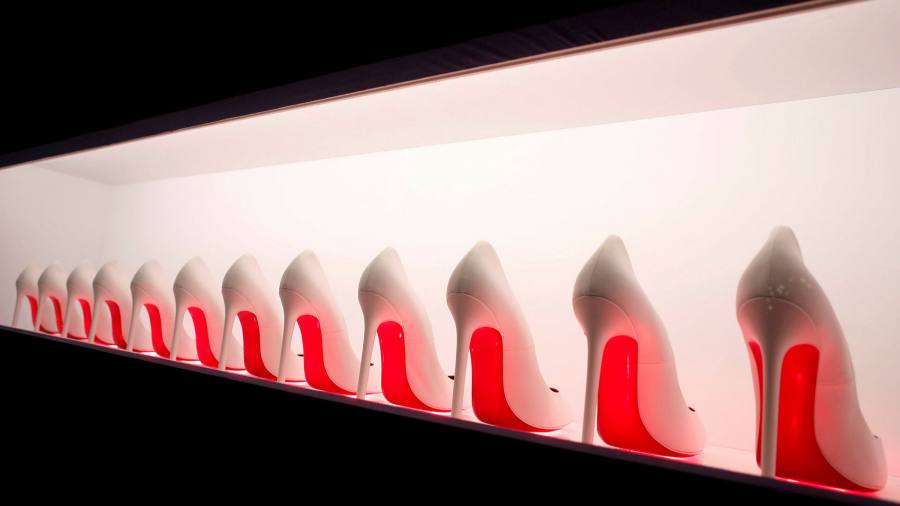[ad_1]
When the Agnelli family’s company Exor acquired a 24 per cent stake in Christian Louboutin this week, it doubled down on red. The family already holds a stake in Ferrari, whose Formula One cars race in that colour. Now it has added the purveyor of red-soled luxury shoes.
The deal values the French designer’s 150 boutiques and trademarked high heels at €2.3bn. That is remarkable, given the industry’s shift from high fashion to casual wear, and a pandemic that has curtailed opportunities to head out on the town, or command attention in the office, in a pair.
Louboutins are expensive — a pair of its iconic Pigalle pumps with 10cm stiletto heels cost £545, and its LoubiShark low-top sneakers with shark tooth red soles are £100 more. Despite the Agnellis’ vote of confidence, it is easy to dismiss them as hedonistic fripperies that sit awkwardly with the times.
But Christian Louboutin pulled off two deceptively difficult tricks at once by painting the sole of a prototype with red lacquer nail polish in 1992. He made his designs instantly recognisable and turned them into symbols of female empowerment. Those are not trivial achievements.
Capturing a colour is hard because colours are public property in all but rare cases. It would be highly valuable to market the only red lipstick, but it is impossible to get copyright or trademark protection to stop rivals producing their own. All that most companies can do is gradually associate their brand with a shade.
Ferrari did so by racing in the Rosso Corsa colour for Italian racing car teams, while Bugattis were painted in Bleu de France. So did the Financial Times by adopting salmon pink newsprint in 1893 to distinguish itself from rivals. But plenty of carmakers sell red cars, and other financial newspapers mimic the FT.
It is easier to protect packaging such as Tiffany’s robin’s–egg blue boxes, although the UK appeal court ruled in 2018 against an effort by Cadbury to trademark its purple chocolate wrapping. But courts are rightly wary of letting any company monopolise a colour for a product itself.
Louboutin’s stroke of genius was to paint only the sole red. A US judge at first rejected his attempt to limit Yves Saint Laurent from selling a red high-heeled pump, ruling that colours are integral to fashion. You cannot trademark a function of a product, such as the shape of a football.Â
But while an appeals court agreed in 2012 that Louboutin could not have red shoes to himself, it gave him rights to “a red, lacquered outsole on a high fashion woman’s shoeâ€, when the upper was a contrasting shade. By decorating the part that other designers ignored, he found a loophole.
Putting red on the bottom of the shoe was more than a legal triumph — it lent Christian Louboutin shoes their peculiar power. The black leather Pigalle pump appears elegant and stern, but the gleam of its “China red†visible on the edge of the soles hints at hidden excitement.
Red was often associated with male authority — Louis XIV of France wore high red-heeled shoes, restricting them to aristocrats, while Catholic cardinals gained the right to wear scarlet mantles centuries ago. Ferrari and Alfa Romeo’s racing colours signal the thrill of male competition.
The colour tilted towards emancipation in the 20th century, with supporters of the women’s suffrage movement marching in New York in 1912 wearing red lipstick given out by Elizabeth Arden. Arden also produced the “Montezuma red†lipstick worn by women US Marine Reserves in the 1940s.
The pivotal moment for red lipstick was Revlon’s advertising campaign for its Fire and Ice lipstick and nail polish in 1952, written by the copywriter Kay Daly. “For you who love to flirt with fire . . . who dare to skate on thin ice,†it proclaimed. The customer was the woman herself, rather than her husband — the product was provocative and sexy, but under her command.
The same spirit inhabits Jennifer Lopez’s 2009 song Louboutins, about leaving an unreliable lover: “I’m throwing on my Louboutins/Watch these red bottoms/And the back of my jeans.†Red is a stop sign as well as a come-on — it is a powerful part of a woman’s armoury.
But I think the ultimate power of Christian Louboutin’s innovation lies in concealment. Many of his shoe designs were extravagant — some of them were associated with fetishism in the early days. But even his black pumps have another side. Red lies hidden, waiting to be deployed.
This echoes men’s tailoring, with dark wool covering colourful silk linings: the British designer Paul Smith offers a tailored grey suit with a turquoise lining and inner pocket flashes. Louboutin gave female executives a similar style of authoritative sobriety, welted to glamour and excitement.
The combination is more powerful than red alone. Christian Louboutin’s invention is now even protected by law, which he cannot have anticipated when he painted his first sole. But that act was worth plenty.
[ad_2]
Source link





